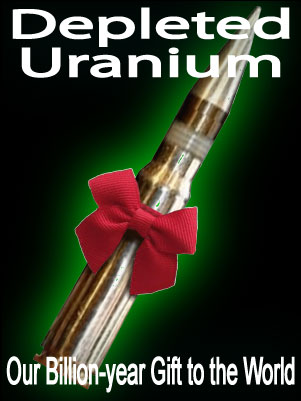 In the 1970s, the Soviet military developed armor plating for their tanks that regular ammunition couldn’t penetrate. The Pentagon began looking for metals to make denser armor-piercing projectiles, and finally settled on depleted uranium (DU). DU is a byproduct of nuclear power generation; after the uranium has been spent in the reactor it leaves behind an isotope of the original uranium that is 1.6 times denser than lead. DU rounds are now common in heavy weapons like tanks, aircraft, and artillery.
In the 1970s, the Soviet military developed armor plating for their tanks that regular ammunition couldn’t penetrate. The Pentagon began looking for metals to make denser armor-piercing projectiles, and finally settled on depleted uranium (DU). DU is a byproduct of nuclear power generation; after the uranium has been spent in the reactor it leaves behind an isotope of the original uranium that is 1.6 times denser than lead. DU rounds are now common in heavy weapons like tanks, aircraft, and artillery.
One of the features of a DU round is the way it behaves when it hits its target. The incredibly dense material focuses all the pressure of the round at the very tip, pushing through virtually any armor. The round shatters on impact and is driven through the hole where the powdered DU then ignites on contact with air, creating a fireball that helps destroy the target. The fireball also almost completely destroys the DU round. Almost. While much is consumed by the fire, the rest is transformed into a very fine dust that is easily carried by the wind, captured by soil, absorbed by plants, or eaten or breathed by animals (and people). This low-level radioactive material has a half life of 4.5 billion years.
DU may be a major improvement in munitions, but the high cost of that improvement is only gradually becoming apparent. Some researchers think Gulf War Syndrome may be caused (at least in part) by DU from the first Gulf War. But more shocking is the effect our DU rounds are believed to be having in Fallujah, Iraq, right now.
Editorial Note:
((By Charles Letherwood, Tom Dwyer Outreach Coordinator) We first became aware of this issue through the accusation that depleted uranium (DU) was responsible for the deaths and birth defects seen in Iraq, so that was how we wrote the story. Since we wrote it, two people have called to say the whole issue is a lie. It was easy to dismiss LtCol Helbig (see Tom’s Tidbits) but harder to dismiss the comments of a friend of mine, Capt. Eugene (Lee) Hill. A friend since college, Lee and I have spent many happy hours flinging epithets at each other across the political divide but I have usually found him to be motivated by integrity and frequently susceptible to logic and science. He cited several reports (among them Bernard Rostker’s “Depleted Uranium: A Case Study of Good and Evil”, James McLaughlin’s “Depleted uranium – a health, environmental, or societal issue?”, and Albert Marshall’s “Analysis of Uranium Dispersal and Health Effects Using a Gulf War Case Study”) that said DU was safe. He also made some disturbing logical points… DU rounds were used much more heavily in the tank battles near Ramallah, but the same infant effects haven’t been seen there. Also, in the industrial area of Falujah, dioxin that was “liberated” by our shelling is floating around the environment. Dioxin is a known cause of birth defects, and could be responsible instead of the DU. He also pointed out that there were no first-source scientific articles in our story, and suggested I rewrite the story appropriately.
We struggled with what to do at this point. When we wrote the article we thought it laid out a fair (if damning) treatment of the DU issue, but now we knew that there was an argument on the other side. What standards should we meet with our newsletter? How ‘proven’ does something have to be before we share it with others? If we are going to write about large issues beyond our area of expertise (like the mortgage crisis, slavery, mountaintop removal mining, and a host of others), what level of investigation do we have to meet before it’s OK to report?
Tom agreed we should at least mention the controversy, which resulted in this month’s Tom’s Tidbits dealing with LtCol Helbig. But in deference to Cpt Hill, we also wanted to at least try to give due diligence to the information he cited on the other side. I looked at the originals for some (but not all) of the documents that Lee mentioned, and also looked deeper into the documents supporting DU health effects. My evaluation (for what it’s worth) is that the “pro” DU papers generally seemed like older studies and reviews based on extrapolations of acute exposures from uranium workers, miners, and military personnel. This would make sense as these papers were prepared when DU was just beginning to be identified as a suspect in Veteran and Iraqi health problems, and no targeted science was available. In addition, I thought some of the pieces (most specifically, the IAEA report on DU) weren’t as definitively “pro” DU as they were portrayed. We also added a review of the current literature surrounding DU health impacts to increase our first-source credibility. (We could find no corresponding literature review on the “pro” DU side). On review, these “anti” DU papers seemed more like direct experimental science based on the DU conditions found in Iraq. While they did show mechanisms by which DU could have the effects it is purported to have, they did not conclusively establish a causal link from DU to either cancer or birth defects in humans. This also would be expected, as science is being brought to bear on a complex question and the answer is only beginning to take shape.
So DU may or may not be the only culprit in the Iraqi births. But as I researched the issue, one of Lee’s questions stuck in my mind. He said that dioxin might be responsible for many of the problems. Would that matter? If we changed the title to “DU and Dioxin… Our Billion Year Gift To The World” would that make things better? I think the birth defect spike probably exists, and that even Col Helbig and Cpt Hill would agree US actions are a little too coincidental not to have some role in it. I think that if there is any possibility of truth to these accusations, then we as a nation have a fundamental duty to determine the extent of that truth so we can act accordingly. In the end, that is the point of this article.)
 Doctors in Fallujah blame depleted uranium used in devastating attacks in 2004 for a catastrophic rise in infant deaths, birth defects, and abnormalities. Iraqi parent’s first question is no longer “is it a boy or girl”, but “is it normal”. To compare: in August 2002 Fallujah General Hospital saw 530 births, 6 deaths, and 1 deformity. In September 2009 the same hospital saw only 170 births. Of those, 41 died and 31 of those had serious abnormalities. A Fallujah pediatrician has documented thousands of these tragedies, but says there are no medical terms to describe them because so many were unknown until we dumped twelve hundred tons of depleted uranium there.
Doctors in Fallujah blame depleted uranium used in devastating attacks in 2004 for a catastrophic rise in infant deaths, birth defects, and abnormalities. Iraqi parent’s first question is no longer “is it a boy or girl”, but “is it normal”. To compare: in August 2002 Fallujah General Hospital saw 530 births, 6 deaths, and 1 deformity. In September 2009 the same hospital saw only 170 births. Of those, 41 died and 31 of those had serious abnormalities. A Fallujah pediatrician has documented thousands of these tragedies, but says there are no medical terms to describe them because so many were unknown until we dumped twelve hundred tons of depleted uranium there.
A WORD OF CAUTION… This article comes from our “News To Make You Furious” column in our monthly newsletter. “News To Make You Furious” is a lighthearted name for a very serious column. We’ve written about some really bad issues ranging from AminoSweet to the Mortgage Crisis to Slavery, and all with the idea that there are some foul things going on in the world and we are better off knowing about them than hiding from them. But THIS story… you can’t “un-know” it. Once you’ve read this article, this abomination in Iraq will stay with you. You NEED to see the pictures of infants affected by this, and the horrific devastation visited upon them and their families. But the images will haunt you, and the shattered lives of these children will scar your dreams. It’s NOT for casual web-surfing, but it IS for people who can’t turn away from the things being done by our country, and in our name.
Not surprisingly, most of the reporting on this issue is coming from Al Jazeera, the CNN of the Middle East. Here are two of their major articles, and some links to images of the DU-Associated birth defects…
Images of Iraqi DU Babies- CAUTION: These are graphic and horrific images. Use your best judgment to decide if you really need to see them.
Still images of many of the infant casualties
Video, with attached letter to the U.N.
But the issue is beginning to get attention from other quarters as well. Here are several articles that deal with DU, its use in Iraq, and the medical science connecting it to health concerns. They are written from both technical and general-information standpoints, by medical and military experts, and from a variety of reporting institutions.
List of Recent Research on Depleted Uranium [Revised May 17, 2009]
A Review of Depleted Uranium Biological Effects: In-vitro and In-vivo studies
Depleted uranium casts shadow over peace in Iraq
The Quantity of Depleted Uranium Used in Iraq
Depleted Uranium Radioactive Contamination In Iraq: An Overview
Horror Of US Depleted Uranium In Iraq Threatens World
The Use of Depleted Uranium in the 2003 Iraq War: An Initial Assessment of Information and Policies
Cancer Spreading In Iraq due to Depleted Uranium Weapons
The Excessive Use of Weapons and Banned Weapons
If you want to get involved, there is at least one organization dedicated to controlling DU weapons…
International Coalition to Ban Uranium Weapons
 The International Coalition to Ban Uranium Weapons (ICBUW) was formed in 2003 in Berlaar, Belgium to promote a campaign based on reliable information on depleted uranium weapons. It is a global coalition of 155 groups in 32 countries campaigning for a ban on the use, transport, manufacture, sale and export of all conventional weapon systems containing uranium (usually called depleted uranium weapons). It also seeks health monitoring and compensation for communities affected by the use of uranium weapons and the environmental remediation of such sites.
The International Coalition to Ban Uranium Weapons (ICBUW) was formed in 2003 in Berlaar, Belgium to promote a campaign based on reliable information on depleted uranium weapons. It is a global coalition of 155 groups in 32 countries campaigning for a ban on the use, transport, manufacture, sale and export of all conventional weapon systems containing uranium (usually called depleted uranium weapons). It also seeks health monitoring and compensation for communities affected by the use of uranium weapons and the environmental remediation of such sites.










